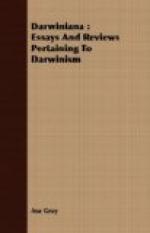An excellent instance of the way in which the derivative hypothesis is practically applied in these days, by a zoologist, is before us in Prof. Flower’s modest and admirable paper on the Ungulata, or hoofed animals, and their geological history. We refer to it here, not so much for the conclusions it reaches or suggests, as to commend the clearness and the impartiality of the handling, and the sobriety and moderation of the deductions. Confining himself “within the region of the known, it is shown that, at least in one group of animals, the facts which we have as yet acquired point to the former existence of various intermediate forms, so numerous that they go far to discredit the view of the sudden introduction of new species. . . . The modern forms are placed along lines which converge toward a common centre.” The gaps between the existing forms of the odd-toed group of ungulates (of which horses, rhinoceroses, and tapirs, are the principal representatives) are most bridged over by palaeontology, and somewhat the same may be said of the even-toed group, to which the ruminants and the porcine genus belong. “Moreover, the lines of both groups to a certain extent approximate, but, within the limits of our knowledge, they do not meet. . — . Was the order according to which the introduction of new forms seems to have taken place since the Eocene then entirely changed, or did it continue as far back as the period when these lines would have been gradually fused in a common centre?”
Facts like these, which suggest grave diversification under long lapse of time, are well supplemented by those which essentially demonstrate a slighter diversification of many species over a wide range of space; whether into species or races depends partly upon how the naturalist uses these terms, partly upon the extent of the observations, or luck in getting together intermediate forms. The researches of Prof. Baird upon the birds of this continent afford a good illustration. A great number of our birds which have been, and must needs have been, regarded as very distinct species, each mainly with its own geographical area, are found to mingle their characters along bordering lines; and the same kinds of differences (of coloration, form, or other) are found to prevail through the species of each region, thus impressing upon them a geographical facies. Upon a submergence of the continent, reducing these several regions to islands sufficiently separated, these forms would be unquestioned species.
Considerations such as these, of which a few specimens have now been adduced (not general speculations, as the unscientific are apt to suppose), and trials of the new views to see how far they will explain the problems or collocate the facts they are severally dealing with, are what have mainly influenced working naturalists in the direction of the provisional acceptance of the derivative hypothesis. They leave to polemical speculators the fruitless discussion of the question whether all species came from one or two, or more; they are trying to grasp the thing by the near, not by the farther end, and to ascertain, first of all, whether it is probable or provable that present species are descendants of former ones which were like them, but less and less like them the farther back we go.




